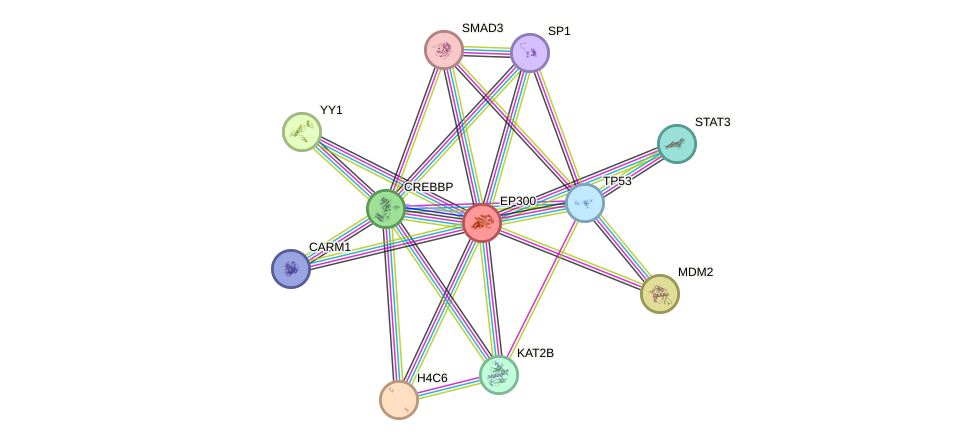GenAge entry for EP300 (Homo sapiens)
Gene name (HAGRID: 94)
- HGNC symbol
- EP300
- Aliases
- p300; KAT3B
- Common name
- E1A binding protein p300
Potential relevance to the human ageing process
- Main reason for selection
- Entry selected based on evidence linking the gene product to the regulation or control of genes previously linked to ageing
- Description
EP300 is a transcriptional coactivator that mediates many transcriptional events including DNA repair. It also acts as a histone acetyltransferase to regulate transcription through chromatin structural changes [514]. EP300 activity is attenuated in ageing mice [426]. Because EP300 has been associated with several other proteins that may be involved in ageing, such as WRN [511], EP300 might somehow impact on human ageing.
Cytogenetic information
- Cytogenetic band
- 22q13.2
- Location
- 41,092,610 bp to 41,180,077 bp
- Orientation
- Plus strand
Protein information
- Gene Ontology
-
Process: GO:0000122; negative regulation of transcription from RNA polymerase II promoter
GO:0001666; response to hypoxia
GO:0001756; somitogenesis
GO:0002223; stimulatory C-type lectin receptor signaling pathway
GO:0006283; transcription-coupled nucleotide-excision repair
GO:0006355; regulation of transcription, DNA-templated
GO:0006366; transcription from RNA polymerase II promoter
GO:0006473; protein acetylation
GO:0006475; internal protein amino acid acetylation
GO:0006915; apoptotic process
GO:0006977; DNA damage response, signal transduction by p53 class mediator resulting in cell cycle arrest
GO:0006990; positive regulation of transcription from RNA polymerase II promoter involved in unfolded protein response
GO:0007219; Notch signaling pathway
GO:0007399; nervous system development
GO:0007507; heart development
GO:0007519; skeletal muscle tissue development
GO:0007623; circadian rhythm
GO:0009887; animal organ morphogenesis
GO:0010506; regulation of autophagy
GO:0010742; macrophage derived foam cell differentiation
GO:0016032; viral process
GO:0018076; N-terminal peptidyl-lysine acetylation
GO:0018393; internal peptidyl-lysine acetylation
GO:0030183; B cell differentiation
GO:0030220; platelet formation
GO:0030324; lung development
GO:0032092; positive regulation of protein binding
GO:0032481; positive regulation of type I interferon production
GO:0034644; cellular response to UV
GO:0035855; megakaryocyte development
GO:0042771; intrinsic apoptotic signaling pathway in response to DNA damage by p53 class mediator
GO:0043627; response to estrogen
GO:0043923; positive regulation by host of viral transcription
GO:0043967; histone H4 acetylation
GO:0043969; histone H2B acetylation
GO:0045444; fat cell differentiation
GO:0045815; positive regulation of gene expression, epigenetic
GO:0045944; positive regulation of transcription from RNA polymerase II promoter
GO:0050821; protein stabilization
GO:0051091; positive regulation of sequence-specific DNA binding transcription factor activity
GO:0051726; regulation of cell cycle
GO:0060765; regulation of androgen receptor signaling pathway
GO:0061418; regulation of transcription from RNA polymerase II promoter in response to hypoxia
GO:0090043; regulation of tubulin deacetylation
GO:1900034; regulation of cellular response to heat
GO:1901796; regulation of signal transduction by p53 class mediator
GO:1904837; beta-catenin-TCF complex assembly
Cellular component: GO:0000123; histone acetyltransferase complex
GO:0005634; nucleus
GO:0005654; nucleoplasm
GO:0005667; transcription factor complex
GO:0005737; cytoplasm
Hide GO termsFunction: GO:0000979; RNA polymerase II core promoter sequence-specific DNA binding
GO:0001047; core promoter binding
GO:0001102; RNA polymerase II activating transcription factor binding
GO:0001228; transcriptional activator activity, RNA polymerase II transcription regulatory region sequence-specific binding
GO:0002039; p53 binding
GO:0003677; DNA binding
GO:0003682; chromatin binding
GO:0003684; damaged DNA binding
GO:0003713; transcription coactivator activity
GO:0004402; histone acetyltransferase activity
GO:0004468; lysine N-acetyltransferase activity, acting on acetyl phosphate as donor
GO:0005515; protein binding
GO:0008013; beta-catenin binding
GO:0008022; protein C-terminus binding
GO:0008134; transcription factor binding
GO:0008270; zinc ion binding
GO:0016407; acetyltransferase activity
GO:0016746; transferase activity, transferring acyl groups
GO:0031490; chromatin DNA binding
GO:0033613; activating transcription factor binding
GO:0034212; peptide N-acetyltransferase activity
GO:0035257; nuclear hormone receptor binding
GO:0050681; androgen receptor binding
GO:0097157; pre-mRNA intronic binding
Protein interactions and network
- Protein-protein interacting partners in GenAge
- TP53, ERCC8, STAT3, STAT5A, AKT1, MYC, FOS, PRKCD, PPARA, HDAC3, PARP1, BRCA1, PIN1, CREBBP, HIF1A, NCOR1, EGR1, NFKB1, UBE2I, EP300, PRKCA, EEF2, TERF1, PRKDC, AR, PCNA, FEN1, TERF2, XRCC6, RB1, GRB2, FOXO3, FOXO1, XPA, RECQL4, SIRT1, HDAC1, MAPK8, YWHAZ, MAPK14, SP1, JUN, CCNA2, MAP3K5, PIK3R1, BMI1, EEF1A1, TFAP2A, CREB1, ATF2, TBP, APEX1, HBP1, PTGS2, CDK1, E2F1, MAX, MDM2, DDIT3, RELA, TCF3, JUND, NBN, NR3C1, CEBPB, ESR1, CTNNB1, MAPT, TP63, POLB, ATR, PCK1, ARNTL, CLOCK, PPARGC1A, PPARG, TP53BP1, NCOR2, TP73, CDKN1A, CTF1
- STRING interaction network
Retrieve sequences for EP300
Homologs in model organisms
In other databases
- CellAge
- This gene is present as EP300

